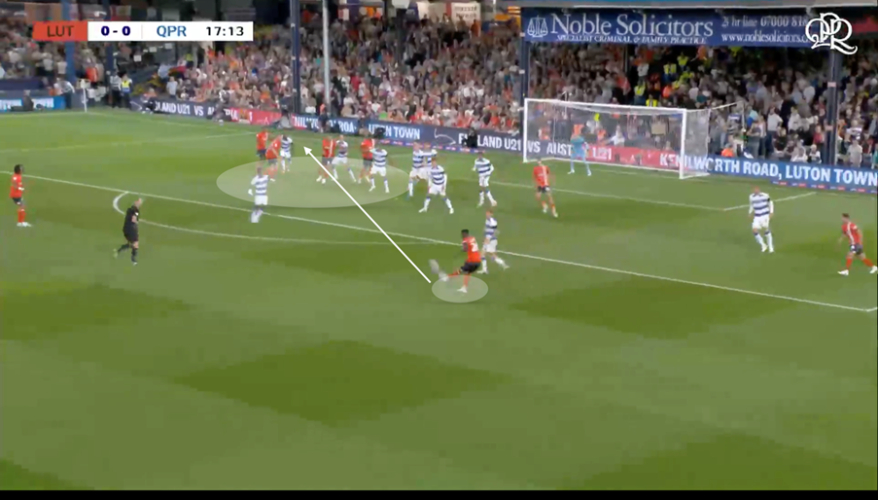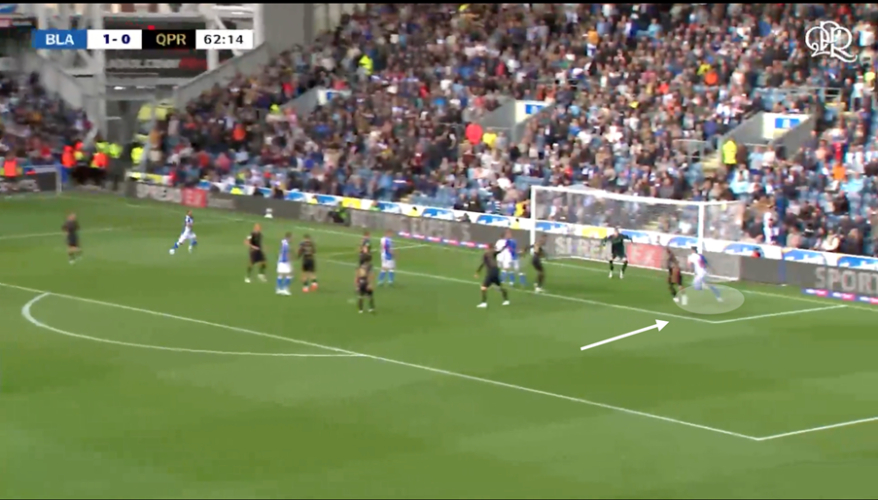Annual set piece therapy – Analysis Friday, 11th Oct 2024 17:19 by Dan Lambert Having gone from worst to best on dead balls at both ends of the pitch by the end of last season, QPR have regressed back to a team leaking a string of remarkably similar goals from corners – Dan Lambert looks at why. Every year I get to write for LoftforWords I seem to torture the readers with pain and misery, because who is analysing all the good about QPR? Firstly, we never get much of a chance to, but also there are also weaknesses or areas of improvement that need highlighting. As we sit in the relegation zone in the second international break of the season, there’s a lot to digest, breakdown and analyse and apologies in advance but this piece involves our defensive set pieces. This is my third season writing for Clive and I’m sure he’s as sick as I am here, yet again, analysing our defensive set pieces. That of course isn’t our only issue at present - we have issues both in and out of possession too - but having watched back the games, looked at the data and seen the trends between games, I believe there are issues within our structure, and the trends opposition teams are exploiting, that are worth highlighting. The focus on this piece was around our goals conceded. We’ve conceded 20 from 12 games, which is close to two per game on average. 35% of our goals conceded so far this season are from set pieces (seven) in all competitions and excluding the first four games (West Brom, Sheff U, Cambridge and Plymouth) where no set piece goals were conceded we’ve conceded the seven goals across the last eight games, near enough averaging a goal a game, and across the last five where we are now winless it most certainly is a goal a game we’ve conceded. In terms of a skim through the data (league data may I add - the two cup games don’t count) we rank 11th for lowest xG conceded from set pieces (as per Opta Analyst) and sixth for fewest shots faced from set pieces. So, in data terms we haven’t been hugely woeful off set pieces in doing the wrong things with huge amounts of shots given away in xG terms. However this is where the use of the two can be used to form an opinion/analysis upon the video/eye test. Hopefully it’ll help understand why the data might be the data but there are flaws defensively in the way we defend and our structure that is causing us bigger problems than it suggests. Luton (H) - EFL Cup QPR set up with 11 defending in our own box, majority man marking or zonal in the six-yard box however Nakamba (left edge of box) is being marked, and Nelson (right edge of box) is totally unmarked.   A cup game admittedly, but that would indicate why our league data would be so ‘low’ in xG terms - the likelihood of that going in regularly or consistently is low, but what the data wouldn’t take into context would be the lack of pressure from defenders which is the case here. Luton (A)    You can see the difference and similarities between the two Luton corners, both of which are from the same side which makes it a good comparison. They utilised the same strengths - second phase dominance with the two edge of box, which we didn’t adapt our structure to from cup to league game - but used a variation to exploit us. Funnily enough if you scroll up to the last screengrab of the cup goal, you’ll see the same image where they utilise the back post overload against us, but that time there was no pressure put on Nelson before he got clean connection with the strike. Crystal Palace (H) - EFL CupThis set piece routine is slightly different, because it is the only goal that isn’t from a corner of the seven, but our defensive structure within this is an issue, and Palace use easy manipulation to draw and attack space.  It’s certainly an interesting set up, do you need eight players along a line with five Palace attackers along the dominant side, six at a push if Guehi walked up to it? You’ve got Nketiah goal side to the free-kick with the space too big for Saito to cover the passing lane, but it’s Munoz who does the most damage here.   Blackburn (A) Within our set-up we went three zonal with a +1 on their two in there, three man-to-man and two out to cover the short leaving their edge of box free and giving us a +1 at the back. It’s worth pointing out not everything at corners has to be man for man, and zonal has its strengths too despite its heavy criticism, but you have to use that +1 to your advantage to make it worthwhile. It’s all about risk and reward.   Excluding the Palace goal, there have already been some key themes with how opposition teams attack corners. Luton have attacked the back post initially, secured the second phase with the players on the edge and either attacked from there or hit the back post, and Blackburn have utilised the players on the edge to draw the defenders out, and attack the back post space from there. Hull (H) – first goal This is definitely a recurring theme for us with leaving the players on the edge spare and being punished for that. It seems odd to go heavily zonal, especially when they play a short one, and not keep one or two attackers high to pull their ‘threats’ away from the edge of the box by keeping them on the halfway line to mark a QPR player.   There’s certainly a hint of fortune with the way the ball fell to Drameh on the edge of the box, but it’s another time that we’ve allowed the player on the edge of the box to get a free shot off, without any pressure from being challenged or marked. If you aren’t going to mark them then that’s fine as long as the reaction is aggressive enough to put bodies in front of the shot or do enough to try and put him off. Hull (H) – second goalIn a game which was heavily decided on set pieces against the run of play, Hull scored a second with similar consistent themes. 
  The way in which that set piece was worked was different to the others, however the principles within that are still the same. Short corner, use the players around the edge to maintain possession and the 2nd phase (by winning it back) and attack the back post to score. Sure, Hull got fortunate with a ricochet and mistake from Andersen on both counts, but their structure was in place to allow them to maintain possession/territory of the corner - by loading the box with 10 which is a risk reward approach, but we always defend the box with 11 so it allows the attacking team to ‘manipulate’ the way they structure their set pieces going forward. Derby (A)This set piece, similar to Palace doesn’t involve quite the same similarities to the others with 2nd phase and back post exploits, but Derby still pull apart areas of our structure.   This is where the structure is interesting: the zonal markers tend to be our tallest players to attack the ball from the delivery, but if the delivery is far deeper then they can’t affect the set piece. I can understand our man markers not starting outside the box as it makes little sense but they need to engage the runners quicker as they have momentum with their start, which we hadn’t done in this situation. It is a brilliant header to be fair.   Final thoughtsA defensive structure mismatch caused the outcome of this corner, and many more of the goals. Our structure has changed ever so slightly per game but the main takeaway is within that we’ve been way too passive. Mismatches, free headers/shots, spare players at the back post or weak defending (e.g not goal side of men - Palace and Blackburn as examples) highlight a real issue. Teams are happy to have players spare on the edge of the box, or to work it short. I have no doubt teams have pinpointed those as ‘target areas’ from analysing our set pieces. Pinning us wide/deep seems to be the theme and either getting shots off from the edge or at the back post will work because we’re weak in duels or not aggressive enough to close down players in possession or space. You could say you’ve seen similar traits in our open play as well. I’m not expecting Cifuentes to change principles of defending numbers in the box, or go man for man, but 75% of teams have exploited us in the same way so things have to be tweaked. In terms of improvements and practical changes, we could change our zonal structure to fewer bodies if they’re delivering short or deeper to counteract the second phase and shots outside the box if there’s no need to defend the six-yard box by having spare defenders. But whatever we do the way we defend has to be more aggressive because teams will target these weaknesses quite easily. Coming out the international break we face Portsmouth, Coventry and Burnley within the space of a week, and I can guarantee you all three teams will look to do the same as others have from the past games. Analysts of those clubs will be watching our last half dozen games and almost all of the goals we’ve conceded have come in this way. More from this author >>> More like this at Dan’s SubStack >>> What have we learned so far? >>> QPR’s attacking set pieces >>> Struggling to break down defences >>> Positive changes v Sheff Utd >>> Ainsworth’s structural headache >>> Suceeding without possession >>> Consistent, persistent failures without the ball >>> Defensive set piece déjà vu >>> How Cifuentes turned it around If you enjoy LoftforWords, please consider supporting the site through a subscription to our Patreon or tip us via our PayPal account loftforwords@yahoo.co.uk. Pictures — QPRPlusPass The Twitter @DanLambert__ Pictures - QPR+ Pass Please report offensive, libellous or inappropriate posts by using the links provided.
You need to login in order to post your comments |
Blogs 31 bloggersLeicester City Polls |
 Hull look to cut it back across to the edge, but Andersen intercepts…
Hull look to cut it back across to the edge, but Andersen intercepts…